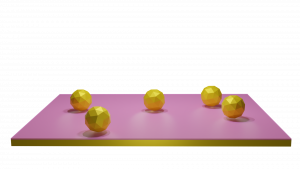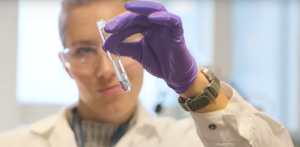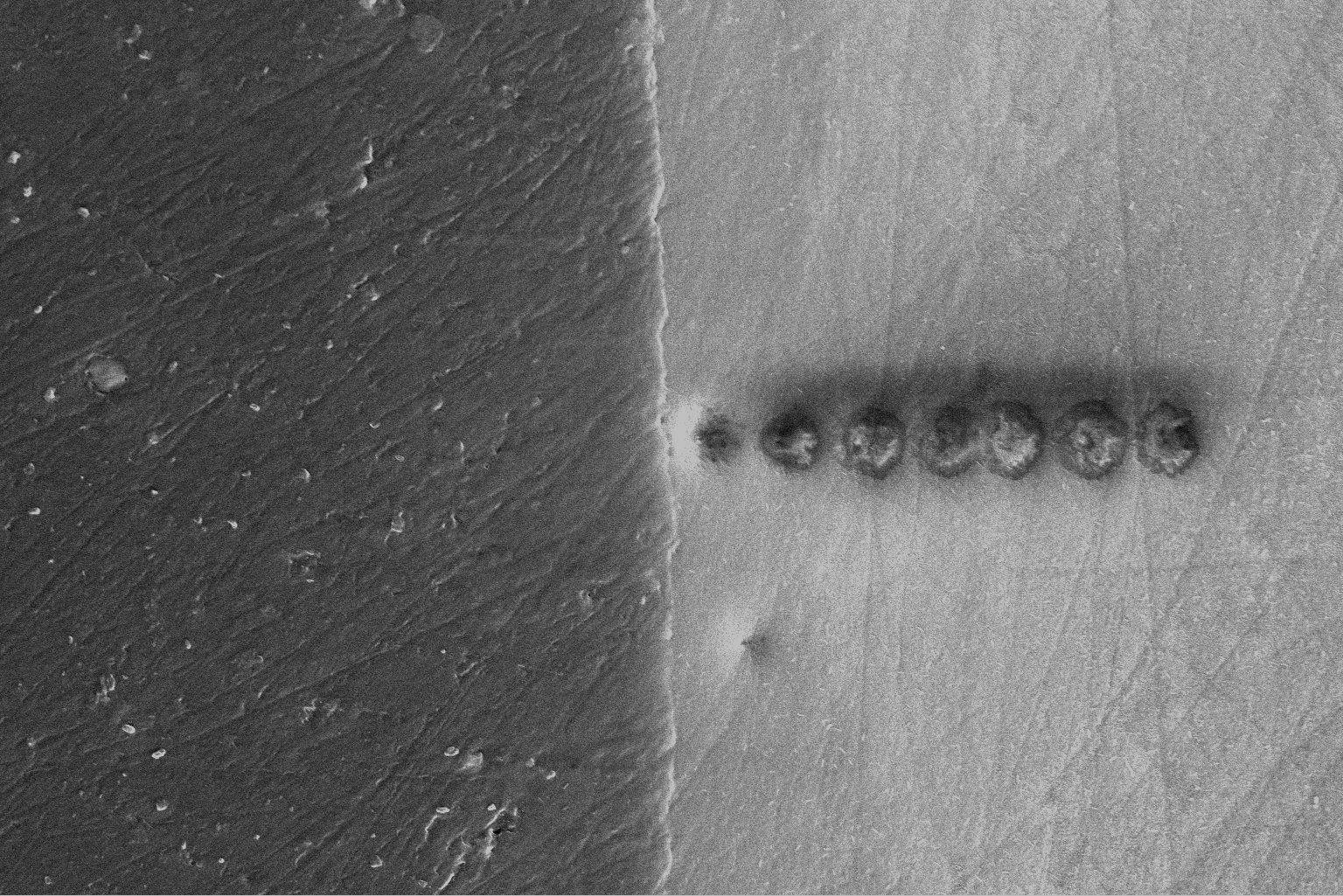Our students have been involved in new and exciting interdisciplinary research and have published in leading high impact journals including Nature Chemistry, Nature Communications, JACS, Angewandte Chemie, Applied Physics Letters, ACS Nano, Nano Letters, Advanced Materials, Nature Protocols, PloS one, and many others.
A full list of the work published by our NanoDTC Students, Associates and others, acknowledging the NanoDTC grants EP/G037221, EP/L015978 and EP/S022953/1 is below. If you want to view the papers on google scholar, see here.
Some papers published by our students are also featured below with some additional contextual information.
Last updated: Mar 2021

Looking inside lithium-ion batteries

Spectroscopy and Electrocatalysis for a Sustainable Future

From waste to fuel: quantifying sustainability

Novel spin states discovered in silicon-based artificial atoms
A step forward in efficient artificial photosynthesis

Self-assembling hydrogels on microfluidic droplets that respond to light or chemical stimuli by disassembling
2024
Ojambati, Oluwafemi S.; Arnardottir, Kristin B.; Lovett, Brendon W.; Keeling, Jonathan; Baumberg, Jeremy J.
Few-emitter lasing in single ultra-small nanocavities Journal Article
In: NANOPHOTONICS, vol. 13, no. 14, pp. 2679-2686, 2024, ISSN: 2192-8606.
@article{WOS:001144906400001b,
title = {Few-emitter lasing in single ultra-small nanocavities},
author = {Oluwafemi S. Ojambati and Kristin B. Arnardottir and Brendon W. Lovett and Jonathan Keeling and Jeremy J. Baumberg},
doi = {10.1515/nanoph-2023-0706},
issn = {2192-8606},
year = {2024},
date = {2024-06-01},
journal = {NANOPHOTONICS},
volume = {13},
number = {14},
pages = {2679-2686},
keywords = {},
pubstate = {published},
tppubtype = {article}
}
Boskovic, Filip; Maffeo, Christopher; Patino-Guillen, Gerardo; Tivony, Ran; Aksimentiev, Aleksei; Keyser, Ulrich F.
Nanopore Translocation Reveals Electrophoretic Force on Noncanonical RNA:DNA Double Helix Journal Article
In: ACS NANO, 2024, ISSN: 1936-0851.
@article{WOS:001237237100001,
title = {Nanopore Translocation Reveals Electrophoretic Force on Noncanonical
RNA:DNA Double Helix},
author = {Filip Boskovic and Christopher Maffeo and Gerardo Patino-Guillen and Ran Tivony and Aleksei Aksimentiev and Ulrich F. Keyser},
doi = {10.1021/acsnano.4c01466},
issn = {1936-0851},
year = {2024},
date = {2024-06-01},
journal = {ACS NANO},
keywords = {},
pubstate = {published},
tppubtype = {article}
}
Ye, Chumei; Lampronti, Giulio I.; McHugh, Lauren N.; Castillo-Blas, Celia; Kono, Ayano; Chen, Celia; Robertson, Georgina P.; Nagle-Cocco, Liam A. V.; Xu, Weidong; Stranks, Samuel D.; Martinez, Valentina; Brekalo, Ivana; Karadeniz, Bahar; Uzarevic, Krunoslav; Xue, Wenlong; Kolodzeiski, Pascal; Das, Chinmoy; Chater, Philip; Keen, David A.; Dutton, Sian E.; Bennett, Thomas D.
Mechanochemically-induced glass formation from two-dimensional hybrid organic-inorganic perovskites Journal Article
In: CHEMICAL SCIENCE, vol. 15, no. 19, pp. 7198-7205, 2024, ISSN: 2041-6520.
@article{WOS:001205133800001,
title = {Mechanochemically-induced glass formation from two-dimensional hybrid
organic-inorganic perovskites},
author = {Chumei Ye and Giulio I. Lampronti and Lauren N. McHugh and Celia Castillo-Blas and Ayano Kono and Celia Chen and Georgina P. Robertson and Liam A. V. Nagle-Cocco and Weidong Xu and Samuel D. Stranks and Valentina Martinez and Ivana Brekalo and Bahar Karadeniz and Krunoslav Uzarevic and Wenlong Xue and Pascal Kolodzeiski and Chinmoy Das and Philip Chater and David A. Keen and Sian E. Dutton and Thomas D. Bennett},
doi = {10.1039/d4sc00905c},
issn = {2041-6520},
year = {2024},
date = {2024-05-01},
journal = {CHEMICAL SCIENCE},
volume = {15},
number = {19},
pages = {7198-7205},
keywords = {},
pubstate = {published},
tppubtype = {article}
}
Pujari, Arvind; Kim, Byung-man; Greenham, Neil C.; Volder, Michael De
Identifying Current Collectors that Enable Light-Battery Interactions Journal Article
In: SMALL METHODS, 2024, ISSN: 2366-9608.
@article{WOS:001214552100001,
title = {Identifying Current Collectors that Enable Light-Battery Interactions},
author = {Arvind Pujari and Byung-man Kim and Neil C. Greenham and Michael De Volder},
doi = {10.1002/smtd.202301572},
issn = {2366-9608},
year = {2024},
date = {2024-05-01},
journal = {SMALL METHODS},
keywords = {},
pubstate = {published},
tppubtype = {article}
}
Mesa, Camilo A.; Sachs, Michael; Pastor, Ernest; Gauriot, Nicolas; Merryweather, Alice J.; Gomez-Gonzalez, Miguel A.; Ignatyev, Konstantin; Gimenez, Sixto; Rao, Akshay; Durrant, James R.; Pandya, Raj
Correlating activities and defects in (photo)electrocatalysts using in-situ multi-modal microscopic imaging Journal Article
In: NATURE COMMUNICATIONS, vol. 15, no. 1, 2024.
@article{WOS:001217774000031,
title = {Correlating activities and defects in (photo)electrocatalysts using
in-situ multi-modal microscopic imaging},
author = {Camilo A. Mesa and Michael Sachs and Ernest Pastor and Nicolas Gauriot and Alice J. Merryweather and Miguel A. Gomez-Gonzalez and Konstantin Ignatyev and Sixto Gimenez and Akshay Rao and James R. Durrant and Raj Pandya},
doi = {10.1038/s41467-024-47870-9},
year = {2024},
date = {2024-05-01},
journal = {NATURE COMMUNICATIONS},
volume = {15},
number = {1},
keywords = {},
pubstate = {published},
tppubtype = {article}
}
Stern, Hannah L.; Gilardoni, Carmem M.; Gu, Qiushi; Barker, Simone Eizagirre; Powell, Oliver F. J.; Deng, Xiaoxi; Fraser, Stephanie A.; Follet, Louis; Li, Chi; Ramsay, Andrew J.; Tan, Hark Hoe; Aharonovich, Igor; Atature, Mete
A quantum coherent spin in hexagonal boron nitride at ambient conditions Journal Article
In: NATURE MATERIALS, 2024, ISSN: 1476-1122.
@article{WOS:001228346800001,
title = {A quantum coherent spin in hexagonal boron nitride at ambient conditions},
author = {Hannah L. Stern and Carmem M. Gilardoni and Qiushi Gu and Simone Eizagirre Barker and Oliver F. J. Powell and Xiaoxi Deng and Stephanie A. Fraser and Louis Follet and Chi Li and Andrew J. Ramsay and Hark Hoe Tan and Igor Aharonovich and Mete Atature},
doi = {10.1038/s41563-024-01887-z},
issn = {1476-1122},
year = {2024},
date = {2024-05-01},
journal = {NATURE MATERIALS},
keywords = {},
pubstate = {published},
tppubtype = {article}
}
Orr, Kieran W. P.; Diao, Jiecheng; Dey, Krishanu; Hameed, Madsar; Dubajic, Milos; Gilbert, Hayley L.; Selby, Thomas A.; Zelewski, Szymon J.; Han, Yutong; Fitzsimmons, Melissa R.; Roose, Bart; Li, Peng; Fan, Jiadong; Jiang, Huaidong; Briscoe, Joe; Robinson, Ian K.; Stranks, Samuel D.
Strain Heterogeneity and Extended Defects in Halide Perovskite Devices Journal Article
In: ACS ENERGY LETTERS, 2024, ISSN: 2380-8195.
@article{WOS:001235278400001,
title = {Strain Heterogeneity and Extended Defects in Halide Perovskite Devices},
author = {Kieran W. P. Orr and Jiecheng Diao and Krishanu Dey and Madsar Hameed and Milos Dubajic and Hayley L. Gilbert and Thomas A. Selby and Szymon J. Zelewski and Yutong Han and Melissa R. Fitzsimmons and Bart Roose and Peng Li and Jiadong Fan and Huaidong Jiang and Joe Briscoe and Ian K. Robinson and Samuel D. Stranks},
doi = {10.1021/acsenergylett.4c00921},
issn = {2380-8195},
year = {2024},
date = {2024-05-01},
journal = {ACS ENERGY LETTERS},
keywords = {},
pubstate = {published},
tppubtype = {article}
}
Gaggio, Benedetta; Jan, Atif; Muller, Moritz; Salonikidou, Barbara; Bakhit, Babak; Hellenbrand, Markus; Martino, Giuliana Di; Yildiz, Bilge; MacManus-Driscoll, Judith L.
Sodium-Controlled Interfacial Resistive Switching in Thin Film Niobium Oxide for Neuromorphic Applications Journal Article
In: CHEMISTRY OF MATERIALS, 2024, ISSN: 0897-4756.
@article{WOS:001237249300001,
title = {Sodium-Controlled Interfacial Resistive Switching in Thin Film Niobium
Oxide for Neuromorphic Applications},
author = {Benedetta Gaggio and Atif Jan and Moritz Muller and Barbara Salonikidou and Babak Bakhit and Markus Hellenbrand and Giuliana Di Martino and Bilge Yildiz and Judith L. MacManus-Driscoll},
doi = {10.1021/acs.chemmater.4c00965},
issn = {0897-4756},
year = {2024},
date = {2024-05-01},
journal = {CHEMISTRY OF MATERIALS},
keywords = {},
pubstate = {published},
tppubtype = {article}
}
Boukouvala, Christina; West, Claire A.; Ten, Andrey; Hopper, Elizabeth; Ramasse, Quentin M.; Biggins, John S.; Ringe, Emilie
Far-field, near-field and photothermal response of plasmonic twinned magnesium nanostructures Journal Article
In: NANOSCALE, vol. 16, no. 15, pp. 7480-7492, 2024, ISSN: 2040-3364.
@article{WOS:001160569400001b,
title = {Far-field, near-field and photothermal response of plasmonic twinned
magnesium nanostructures},
author = {Christina Boukouvala and Claire A. West and Andrey Ten and Elizabeth Hopper and Quentin M. Ramasse and John S. Biggins and Emilie Ringe},
doi = {10.1039/d3nr05848d},
issn = {2040-3364},
year = {2024},
date = {2024-04-01},
journal = {NANOSCALE},
volume = {16},
number = {15},
pages = {7480-7492},
keywords = {},
pubstate = {published},
tppubtype = {article}
}
Horstig, Felix-Ekkehard; Ibberson, David J.; Oakes, Giovanni A.; Cochrane, Laurence; Wise, David F.; Stelmashenko, Nadia; Barraud, Sylvain; Robinson, Jason A. W.; Martins, Frederico; Gonzalez-Zalba, M. Fernando
Multimodule microwave assembly for fast readout and charge-noise characterization of silicon quantum dots Journal Article
In: PHYSICAL REVIEW APPLIED, vol. 21, no. 4, 2024, ISSN: 2331-7019.
@article{WOS:001227705300002,
title = {Multimodule microwave assembly for fast readout and charge-noise
characterization of silicon quantum dots},
author = {Felix-Ekkehard Horstig and David J. Ibberson and Giovanni A. Oakes and Laurence Cochrane and David F. Wise and Nadia Stelmashenko and Sylvain Barraud and Jason A. W. Robinson and Frederico Martins and M. Fernando Gonzalez-Zalba},
doi = {10.1103/PhysRevApplied.21.044016},
issn = {2331-7019},
year = {2024},
date = {2024-04-01},
journal = {PHYSICAL REVIEW APPLIED},
volume = {21},
number = {4},
keywords = {},
pubstate = {published},
tppubtype = {article}
}
Moysidou, Chrysanthi-Maria; Niekerk, Douglas C.; Stoeger, Verena; Pitsalidis, Charalampos; Draper, Lorraine A.; Withers, Aimee M.; Hughes, Katherine; McCoy, Reece; Acharya, Rachana; Hill, Colin; Owens, Roisin M.
Modelling Human Gut-Microbiome Interactions in a 3D Bioelectronic Platform Journal Article
In: SMALL SCIENCE, 2024, ISSN: 2688-4046.
@article{WOS:001206209700001,
title = {Modelling Human Gut-Microbiome Interactions in a 3D Bioelectronic
Platform},
author = {Chrysanthi-Maria Moysidou and Douglas C. Niekerk and Verena Stoeger and Charalampos Pitsalidis and Lorraine A. Draper and Aimee M. Withers and Katherine Hughes and Reece McCoy and Rachana Acharya and Colin Hill and Roisin M. Owens},
doi = {10.1002/smsc.202300349},
issn = {2688-4046},
year = {2024},
date = {2024-04-01},
journal = {SMALL SCIENCE},
keywords = {},
pubstate = {published},
tppubtype = {article}
}
Morzy, Jedrzej K.; Dose, Wesley M.; Vullum, Per Erik; Lai, May Ching; Mahadevegowda, Amoghavarsha; Volder, Michael F. L. De; Ducati, Caterina
Origins and Importance of Intragranular Cracking in Layered Lithium Transition Metal Oxide Cathodes Journal Article
In: ACS APPLIED ENERGY MATERIALS, vol. 7, no. 9, pp. 3945-3956, 2024, ISSN: 2574-0962.
@article{WOS:001226241300001,
title = {Origins and Importance of Intragranular Cracking in Layered Lithium
Transition Metal Oxide Cathodes},
author = {Jedrzej K. Morzy and Wesley M. Dose and Per Erik Vullum and May Ching Lai and Amoghavarsha Mahadevegowda and Michael F. L. De Volder and Caterina Ducati},
doi = {10.1021/acsaem.4c00279},
issn = {2574-0962},
year = {2024},
date = {2024-04-01},
journal = {ACS APPLIED ENERGY MATERIALS},
volume = {7},
number = {9},
pages = {3945-3956},
keywords = {},
pubstate = {published},
tppubtype = {article}
}
Gregg, Aoife; Volder, Michael De; Baumberg, Jeremy J.
Kinetics of Light-Responsive CNT/PNIPAM Hydrogel Microactuators Journal Article
In: SMALL, vol. 20, no. 9, 2024, ISSN: 1613-6810.
@article{WOS:001093584800001b,
title = {Kinetics of Light-Responsive CNT/PNIPAM Hydrogel Microactuators},
author = {Aoife Gregg and Michael De Volder and Jeremy J. Baumberg},
doi = {10.1002/smll.202305034},
issn = {1613-6810},
year = {2024},
date = {2024-03-01},
journal = {SMALL},
volume = {20},
number = {9},
keywords = {},
pubstate = {published},
tppubtype = {article}
}
Wiita, Elizabeth G.; Toprakcioglu, Zenon; Jayaram, Akhila K.; Knowles, Tuomas P. J.
Selenium-silk microgels as antifungal and antibacterial agents Journal Article
In: NANOSCALE HORIZONS, vol. 9, no. 4, pp. 609-619, 2024, ISSN: 2055-6756.
@article{WOS:001152323000001b,
title = {Selenium-silk microgels as antifungal and antibacterial agents},
author = {Elizabeth G. Wiita and Zenon Toprakcioglu and Akhila K. Jayaram and Tuomas P. J. Knowles},
doi = {10.1039/d3nh00385j},
issn = {2055-6756},
year = {2024},
date = {2024-03-01},
journal = {NANOSCALE HORIZONS},
volume = {9},
number = {4},
pages = {609-619},
keywords = {},
pubstate = {published},
tppubtype = {article}
}
Naegele, Tobias E.; Gurke, Johannes; Rognin, Etienne; Willis-Fox, Niamh; Dennis, Anthony; Tao, Xudong; Daly, Ronan; Keyser, Ulrich F.; Malliaras, George G.
Redox Flow Iontophoresis for Continuous Drug Delivery Journal Article
In: ADVANCED MATERIALS TECHNOLOGIES, vol. 9, no. 6, 2024, ISSN: 2365-709X.
@article{WOS:001149790300001b,
title = {Redox Flow Iontophoresis for Continuous Drug Delivery},
author = {Tobias E. Naegele and Johannes Gurke and Etienne Rognin and Niamh Willis-Fox and Anthony Dennis and Xudong Tao and Ronan Daly and Ulrich F. Keyser and George G. Malliaras},
doi = {10.1002/admt.202301641},
issn = {2365-709X},
year = {2024},
date = {2024-03-01},
journal = {ADVANCED MATERIALS TECHNOLOGIES},
volume = {9},
number = {6},
keywords = {},
pubstate = {published},
tppubtype = {article}
}
Cascales-Sandoval, Miguel A.; Hierro-Rodriguez, A.; Ruiz-Gomez, S.; Skoric, L.; Donnelly, C.; Nino, M. A.; McGrouther, D.; McVitie, S.; Flewett, S.; Jaouen, N.; Belkhou, R.; Foerster, M.; Fernandez-Pacheco, A.
Determination of optimal experimental conditions for accurate 3D reconstruction of the magnetization vector via XMCD-PEEM Journal Article
In: JOURNAL OF SYNCHROTRON RADIATION, vol. 31, no. 2, pp. 336-342, 2024, ISSN: 0909-0495.
@article{WOS:001206975000016,
title = {Determination of optimal experimental conditions for accurate 3D
reconstruction of the magnetization vector via XMCD-PEEM},
author = {Miguel A. Cascales-Sandoval and A. Hierro-Rodriguez and S. Ruiz-Gomez and L. Skoric and C. Donnelly and M. A. Nino and D. McGrouther and S. McVitie and S. Flewett and N. Jaouen and R. Belkhou and M. Foerster and A. Fernandez-Pacheco},
doi = {10.1107/S1600577524001073},
issn = {0909-0495},
year = {2024},
date = {2024-03-01},
journal = {JOURNAL OF SYNCHROTRON RADIATION},
volume = {31},
number = {2},
pages = {336-342},
keywords = {},
pubstate = {published},
tppubtype = {article}
}
Lundberg, Theodor; Ibberson, David J.; Li, Jing; Hutin, Louis; Abadillo-Uriel, Jose C.; Filippone, Michele; Bertrand, Benoit; Nunnenkamp, Andreas; Lee, Chang-Min; Stelmashenko, Nadia; Robinson, Jason W. A.; Vinet, Maud; Ibberson, Lisa; Niquet, Yann-Michel; Gonzalez-Zalba, M. Fernando
Non-symmetric Pauli spin blockade in a silicon double quantum dot Journal Article
In: NPJ QUANTUM INFORMATION, vol. 10, no. 1, 2024.
@article{WOS:001179843500001b,
title = {Non-symmetric Pauli spin blockade in a silicon double quantum dot},
author = {Theodor Lundberg and David J. Ibberson and Jing Li and Louis Hutin and Jose C. Abadillo-Uriel and Michele Filippone and Benoit Bertrand and Andreas Nunnenkamp and Chang-Min Lee and Nadia Stelmashenko and Jason W. A. Robinson and Maud Vinet and Lisa Ibberson and Yann-Michel Niquet and M. Fernando Gonzalez-Zalba},
doi = {10.1038/s41534-024-00820-1},
year = {2024},
date = {2024-03-01},
journal = {NPJ QUANTUM INFORMATION},
volume = {10},
number = {1},
keywords = {},
pubstate = {published},
tppubtype = {article}
}
Sibug-Torres, Sarah May; Grys, David-Benjamin; Kang, Gyeongwon; Niihori, Marika; Wyatt, Elle; Spiesshofer, Nicolas; Ruane, Ashleigh; Nijs, Bart; Baumberg, Jeremy J.
In situ electrochemical regeneration of nanogap hotspots for continuously reusable ultrathin SERS sensors Journal Article
In: NATURE COMMUNICATIONS, vol. 15, no. 1, 2024.
@article{WOS:001180826600030,
title = {In situ electrochemical regeneration of nanogap hotspots for
continuously reusable ultrathin SERS sensors},
author = {Sarah May Sibug-Torres and David-Benjamin Grys and Gyeongwon Kang and Marika Niihori and Elle Wyatt and Nicolas Spiesshofer and Ashleigh Ruane and Bart Nijs and Jeremy J. Baumberg},
doi = {10.1038/s41467-024-46097-y},
year = {2024},
date = {2024-03-01},
journal = {NATURE COMMUNICATIONS},
volume = {15},
number = {1},
keywords = {},
pubstate = {published},
tppubtype = {article}
}
Gray, Victor; Toolan, Daniel T. W.; Dowland, Simon; Allardice, Jesse R.; Weir, Michael P.; Zhang, Zhilong; Xiao, James; Klimash, Anastasia; Winkel, Jurjen F.; Holland, Emma K.; Fregoso, Garrett M.; Anthony, John E.; Bronstein, Hugo; Friend, Richard; Ryan, Anthony J.; Jones, Richard A. L.; Greenham, Neil C.; Rao, Akshay
Ligand-Directed Self-Assembly of Organic-Semiconductor/Quantum-Dot Blend Films Enables Efficient Triplet Exciton-Photon Conversion Journal Article
In: JOURNAL OF THE AMERICAN CHEMICAL SOCIETY, vol. 146, no. 11, pp. 7763-7770, 2024, ISSN: 0002-7863.
@article{WOS:001181869900001,
title = {Ligand-Directed Self-Assembly of Organic-Semiconductor/Quantum-Dot Blend
Films Enables Efficient Triplet Exciton-Photon Conversion},
author = {Victor Gray and Daniel T. W. Toolan and Simon Dowland and Jesse R. Allardice and Michael P. Weir and Zhilong Zhang and James Xiao and Anastasia Klimash and Jurjen F. Winkel and Emma K. Holland and Garrett M. Fregoso and John E. Anthony and Hugo Bronstein and Richard Friend and Anthony J. Ryan and Richard A. L. Jones and Neil C. Greenham and Akshay Rao},
doi = {10.1021/jacs.4c00125},
issn = {0002-7863},
year = {2024},
date = {2024-03-01},
journal = {JOURNAL OF THE AMERICAN CHEMICAL SOCIETY},
volume = {146},
number = {11},
pages = {7763-7770},
keywords = {},
pubstate = {published},
tppubtype = {article}
}
Baikie, Tomi K.; Daiber, Benjamin; Kensington, Emil; Xiao, James; Greenham, Neil C.; Ehrler, Bruno; Rao, Akshay
Revealing the potential of luminescent solar concentrators in real-world environments Journal Article
In: JOULE, vol. 8, no. 3, 2024, ISSN: 2542-4351.
@article{WOS:001215820700001,
title = {Revealing the potential of luminescent solar concentrators in real-world
environments},
author = {Tomi K. Baikie and Benjamin Daiber and Emil Kensington and James Xiao and Neil C. Greenham and Bruno Ehrler and Akshay Rao},
doi = {10.1016/j.joule.2024.01.018},
issn = {2542-4351},
year = {2024},
date = {2024-03-01},
journal = {JOULE},
volume = {8},
number = {3},
keywords = {},
pubstate = {published},
tppubtype = {article}
}

